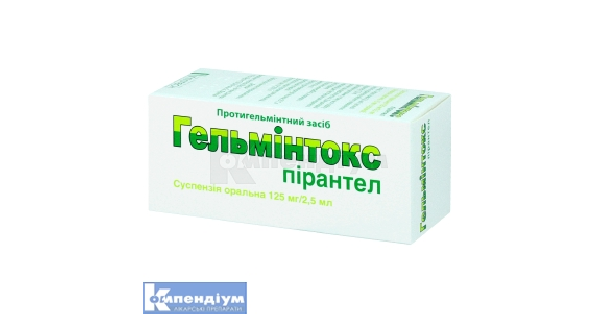

GEL'MINTOKS

Ask a doctor about a prescription for GEL'MINTOKS

How to use GEL'MINTOKS
INSTRUCTIONS for medical use of the drug FOCITAN 0.66 mmol/ml
Composition
The active substance is glucose-1-phosphate disodium tetrahydrate;
250.8 mg of glucose-1-phosphate disodium tetrahydrate per 1 ml of concentrate for solution for infusions;
1 ampoule (10 ml) contains 2508 mg of glucose-1-phosphate disodium tetrahydrate;
0.66 mmol/ml (20.46 mg/ml) of phosphorus;
0.66 mmol/ml (118.8 mg/ml) of glucose;
0.66 mmol/ml (62.7 mg/ml) of phosphates;
1.33 mmol/ml (30.66 mg/ml) of sodium;
osmolarity 1800 mOsm/l;
osmolality from 1525 to 1680 mOsm/kg;
density (20 °C) 1.126 g/cm3;
pH from 7.0 to 10.
The auxiliary substance is water for injection.
Pharmaceutical form
Concentrate for solution for infusions.
Main physico-chemical properties
A clear solution from colorless to yellowish color.
Pharmacotherapeutic group
Blood substitutes and perfusion solutions. Additives for intravenous solutions.
ATC code V05XA09.
Pharmacological properties
Pharmacodynamics
The phosphate ion is the main anion of intracellular fluids. It is present in the body by 80% in the divalent form (HPO42-) and by 20% in the monovalent form (H2PO4-).
The phosphate ion participates in several physiological processes: maintaining intracellular calcium concentration, carbohydrate and lipid metabolism, as a buffer of intracellular fluid, in cellular metabolism and elimination of H+ ions in the kidneys.
The normal concentration of phosphate ions in plasma is from 0.8 to 1.5 mmol/l.
Approximately 85% of phosphates present in the body are found in bones and teeth, and the remaining 15% are distributed in the blood and soft tissues.
Phosphorus is involved in the work of the heart and diaphragm muscles, probably through intracellular ATP.
Phosphorus regulates the affinity of hemoglobin for oxygen and thus participates in the regulation of oxygen transport to tissues.
Knowledge of the probable causes of hypophosphatemia is the basis for introducing the most appropriate treatment.
Pharmacokinetics
The phosphate ion is excreted by the kidneys.
The concentration of phosphate in the glomerular ultrafiltrate is very close to its concentration in plasma. The filtered phosphate is reabsorbed mainly by the proximal tubule (65-80%) and a smaller part (5-10%) by the distal tubule. The net reabsorption is saturated and reaches a plateau when the phosphate concentration in plasma increases.
If kidney function is not impaired, from 15 to 20% of the filtered phosphate load is excreted in the urine.
Preclinical safety data
To date, there are no relevant preclinical data on the toxicity of repeated administration, genotoxicity, carcinogenicity, and reproductive function.
Clinical characteristics
Indications
The drug FOCITAN 0.66 mmol/ml is used:
- to correct moderate and severe hypophosphatemia when oral administration is impossible;
- as a phosphate component in parenteral nutrition.
Contraindications
This product should not be administered in the following situations:
- Severe chronic kidney failure, except in cases where the phosphate level is carefully controlled and there is a need for phosphate supplementation.
- Hyperphosphatemia.
- Hypercalcemia, due to possible deposition of calcium in soft tissues.
- Childhood up to 12 months.
Interaction with other medicinal products and other types of interactions
Combinations to be considered
- Salicylates. Increased excretion of salicylates due to alkalization of urine.
Special warnings and precautions for use
It should be remembered that the preparation contains sodium and glucose.
This medicinal product contains 306.6 mg of sodium per 1 ampoule, which is equivalent to 15.33% of the WHO-recommended maximum daily intake of 2 g of sodium for an adult. Caution should be exercised when administering to patients on a sodium-controlled diet.
Special precautions for use
It is necessary to carefully monitor the concentrations of electrolytes in plasma and, in particular, the concentrations of calcium and phosphates in blood serum, which should be checked every 12-24 hours.
Mandatory monitoring of kidney function. The dose should be reduced in patients with impaired kidney function.
Use during pregnancy or breastfeeding
In case of need, this preparation can be used during pregnancy and breastfeeding.
Ability to influence the reaction rate when driving vehicles or other mechanisms
Data not available.
Method of administration and dosage
Precautions
HYPERTONIC SOLUTION - MUST BE DILUTED BEFORE USE.
FOCITAN 0.66 mmol/ml should be diluted taking into account the appropriate final osmolarity.
For example:
- from 10 ml to 30 ml of FOCITAN 0.66 mmol/ml can be diluted in 250 ml of 0.9% sodium chloride solution for infusions;
- from 10 ml to 30 ml of FOCITAN 0.66 mmol/ml can be diluted in 250 ml of 5% glucose solution for infusion.
The solutions obtained after dilution must be checked for any changes in color and/or formation of precipitate, insoluble complex, or crystals before infusion.
Dosage
Children
During parenteral nutrition, the recommended intake of phosphorus is:
- children from 12 months - 0.2 mmol (6 mg) of phosphorus/kg/day.
Adults
Parenteral nutrition
Generally, the recommended intake during parenteral nutrition is from 10 to 30 mmol of phosphorus (i.e., from 310 to 930 mg of phosphorus) per day throughout the entire period of parenteral nutrition.
Correction of hypophosphatemia
The cumulative dose should be adjusted according to the patient's body weight and phosphate deficit in blood serum. Indications throughout 6 hours can be administered in the following doses:
| Hypophosphatemia | 40-60 kg | 61-80 kg | 81-120 kg |
|---|---|---|---|
| Severe (< 1.0 mg/dl, or 0.32 mmol/l) | 0.125 mmol P/kg/h | 0.095 mmol P/kg/h | 0.07 mmol P/kg/h |
| Moderate (1.0-1.7 mg/dl, or 0.32-0.55 mmol/l) | 0.083 mmol P/kg/h | 0.07 mmol P/kg/h | 0.055 mmol P/kg/h |
P - phosphorus
In the absence of kidney function disorders and electrolyte levels in the blood, treatment can be continued with divided doses (the same dose can be repeated at 6-hour intervals) until the phosphorus level in blood serum reaches 2 mg/dl or 0.7 mmol/l. The average duration of treatment is several hours, but can last up to 3 days.
In adults, the usual infusion rate is up to 10 mmol/h and can reach up to 20 mmol/h in exceptional cases when administered in the intensive care unit in case of severe, life-threatening symptomatic hypophosphatemia.
Method of administration
Slow intravenous infusion.
Children
Used in children from 12 months old.
Overdose
Overdose or too rapid infusion can lead to hyperphosphatemia (see "Adverse reactions" section), hyperglycemia, and water-electrolyte imbalance (sodium and water retention).
Treatment of overdose involves immediate cessation of phosphorus administration and correction of water-electrolyte imbalance.
There may be a need for special measures to reduce phosphatemias, such as oral administration of a phosphate-binding agent or hemodialysis.
Adverse reactions
The frequency of adverse reactions is determined according to the following conditions: very common (≥ 1/10); common (≥ 1/100, < 1/10); uncommon (≥ 1/1000, < 1/100); rare (≥ 1/10000, < 1/1000); very rare (< 1/10000) and unknown frequency (cannot be estimated from available data).
- Metabolic and nutritional disorders
- Hyperphosphatemia: rare, except for existing disorders that reduce the filtration of inorganic phosphate, increasing its level in blood serum (kidney failure), which shift intracellular phosphate into the extracellular space (lactic acidosis, hemolysis, rhabdomyolysis, tissue destruction) or lead to excessive absorption from the gastrointestinal tract and increased renal reabsorption (vitamin D intoxication, acromegaly).
- General disorders and administration site reactions
- Hyperphosphatemia can lead to precipitation of calcium phosphate salts in soft tissues with ectopic calcification and lead to hypocalcemia (frequency unknown).
Reporting suspected adverse reactions
Reporting adverse reactions after registration of the medicinal product is important. This allows monitoring the benefit/risk ratio of this medicinal product. Medical and pharmaceutical workers, as well as patients or their authorized representatives, should report all suspected adverse reactions and lack of efficacy of the medicinal product through the Automated Information System for Pharmacovigilance at: https://aisf.dec.gov.ua/.
Shelf life
3 years.
After opening and dilution: the physico-chemical stability of the medicinal product, diluted in infusion solutions mentioned in the "Special warnings and precautions for use" section, has been demonstrated for 24 hours at 25 °C. However, from a microbiological point of view, the medicinal product should be used immediately after dilution. If it is not used immediately, the responsibility for the duration and conditions of storage rests solely with the user.
Storage conditions
No special storage conditions are required for this medicinal product.
Storage conditions after dilution of the medicinal product are specified in the "Shelf life" section.
Store in a place inaccessible to children.
Incompatibility
Calcium salts.
Alkaline salts.
Since FOCITAN 0.66 mmol/ml has an alkaline pH, it should not be mixed with preparations incompatible with alkaline solutions (e.g., midazolam).
This medicinal product should not be mixed with other medicinal products, except those specified in the "Method of administration and dosage" section.
Packaging
10 ml in a polypropylene ampoule; 10 (5 x 2) ampoules in a cardboard box.
Release category
By prescription.
Manufacturer
Laboratoire Aguettant, France.
Location of the manufacturer and address of the place of business
Le di Chantecaille, Champagne, 07340, France
- Country of registration
- Active substance
- Prescription requiredNo
- Manufacturer
- This information is for reference only and does not constitute medical advice. Always consult a licensed doctor before taking any medication. Oladoctor is not responsible for medical decisions based on this content.
- Alternatives to GEL'MINTOKSDosage form: tablets, 125mgActive substance: pyrantelManufacturer: Іннотера ШузіPrescription not requiredDosage form: tablets, 250mgActive substance: pyrantelManufacturer: Іннотера ШузіPrescription not requiredDosage form: suspension, 250mg/5mlActive substance: pyrantelManufacturer: ТОВ "КУСУМ ФАРМPrescription not required
Alternatives to GEL'MINTOKS in other countries
The best alternatives with the same active ingredient and therapeutic effect.
Alternative to GEL'MINTOKS in Poland
Online doctors for GEL'MINTOKS
Discuss dosage, side effects, interactions, contraindications, and prescription renewal for GEL'MINTOKS – subject to medical assessment and local rules.














